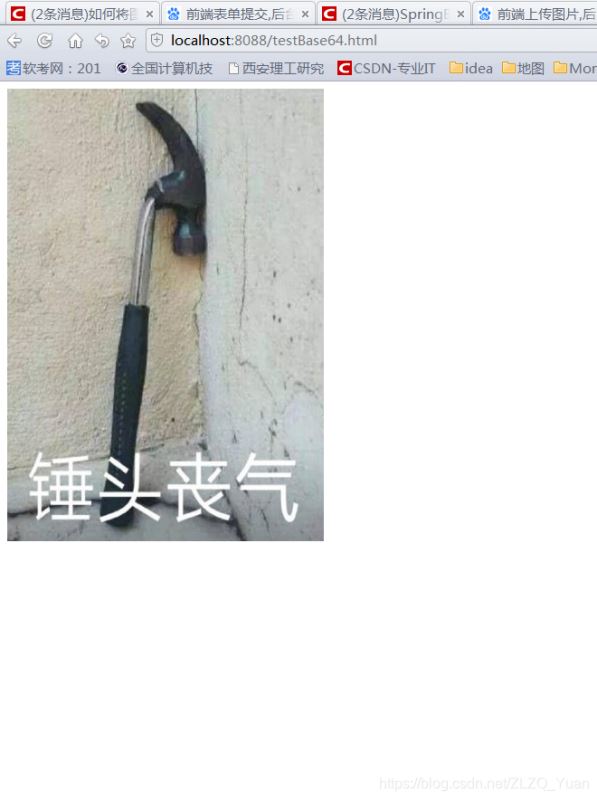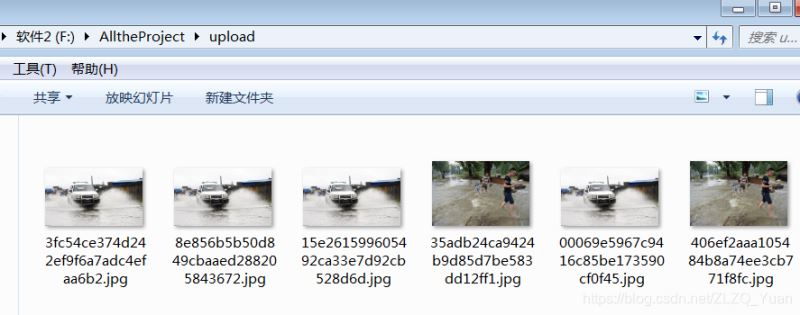Method1:采用BLOB数据格式存图片。
其实这种方式很不合理,数据库大小会激增会导致简单的查询都及其缓慢。
Method2:采用文本格式存储图片。
虽然也不怎么合理,因为关系型数据库本身就不太适合存巨长的大数据量的东西。
但是由于只涉及到base64加密和解码,且可以都写入后台部分,减轻前端负担。
Method3:将图片单独存放在某个服务器上,数据库只存放他们的url地址。
最高效也是最常用的方法。
后面有展示两种示例。
详细代码示例
Method1详细代码示例:
由于目前做的这个项目,同学A之前一直使用的这种方式将文件中的图片读取到数据库表,所以我只写了对BloB类型图片的取数据部分的代码。且过程较繁琐,可用性不强,就不贴了。
这个代码是A给我发的,实在太久了,她也忘了出处了。有人知道请艾特我一下,我标上链接。
package org.springboot.wechatcity.utill;
import java.io.FileInputStream;
import java.io.FileOutputStream;
import java.io.InputStream;
import java.io.OutputStream;
import java.sql.Blob;
import java.sql.Connection;
import java.sql.PreparedStatement;
import java.sql.ResultSet;
/**
* 存入和读取Blob类型的JDBC数据
*/
public class BlobUtill {
public void getBlob() {//读取Blob数据
Connection con = null;
PreparedStatement ps = null;
ResultSet rs = null;
try {
con = JDBCTools.getConnection();
String sql = "SELECT id,name,age,picture FROM animal WHERE id=5";
ps = con.prepareStatement(sql);
rs = ps.executeQuery();
if (rs.next()) {
int id = rs.getInt(1);
String name = rs.getString(2);
int age = rs.getInt(3);
Blob picture = rs.getBlob(4);//得到Blob对象
//开始读入文件
InputStream in = picture.getBinaryStream();
OutputStream out = new FileOutputStream("cat.png");
byte[] buffer = new byte[1024];
int len = 0;
while ((len = in.read(buffer)) != -1) {
out.write(buffer, 0, len);
}
}
} catch (Exception e) {
e.printStackTrace();
}
}
public void insertBlob() {//插入Blob
Connection con = null;
PreparedStatement ps = null;
try {
con = JDBCTools.getConnection();
String sql = "INSERT INTO animal(name,age,picture) VALUES(?,?,?)";
ps = con.prepareStatement(sql);
ps.setString(1, "TheCat");
ps.setInt(2, 8);
InputStream in = new FileInputStream("J:/test1/TomCat.png");//生成被插入文件的节点流
//设置Blob
ps.setBlob(3, in);
ps.executeUpdate();
} catch (Exception e) {
e.printStackTrace();
} finally {
JDBCTools.release(con, ps);
}
}
}
package org.springboot.wechatcity.utill;
import java.io.InputStream;
import java.sql.*;
import java.util.Properties;
/**
* JDBC工具类 用来建立连接和释放连接
*/
public class JDBCTools {
public static Connection getConnection() throws Exception {//连接数据库
String driverClass = "com.mysql.cj.jdbc.Driver";
String url = "jdbc:mysql://IP号:端口号/hmCity?useUnicode=true&characterEncoding=utf8&useSSL=false&serverTimezone=Asia/Shanghai";
String user = "";
String password = "";
Properties properties = new Properties();
InputStream in = Review.class.getClassLoader().getResourceAsStream("jdbc.properties");
properties.load(in);
driverClass = properties.getProperty("driver");
url = properties.getProperty("jdbcurl");
user = properties.getProperty("user");
password = properties.getProperty("password");
Class.forName(driverClass);
return DriverManager.getConnection(url, user, password);
}
public static void release(Connection con, Statement state) {//关闭数据库连接
if (state != null) {
try {
state.close();
} catch (SQLException e) {
e.printStackTrace();
}
}
if (con != null) {
try {
con.close();
} catch (SQLException e) {
e.printStackTrace();
}
}
}
public static void release(ResultSet rs, Connection con, Statement state) {//关闭数据库连接
if (rs != null) {
try {
rs.close();
} catch (SQLException e) {
e.printStackTrace();
}
}
if (state != null) {
try {
state.close();
} catch (SQLException e) {
e.printStackTrace();
}
}
if (con != null) {
try {
con.close();
} catch (SQLException e) {
e.printStackTrace();
}
}
}
}
Method2 详细代码示例:包括存和取的代码
示例:前端以表单形式提交数据信息和图片,后台以MultipartFile类型接收图片,并对图片进行BASE64编码,存储在mysql数据库中。
1.BASE64存图片。
note:建议图片处理部分单独写在service层,比较符合分层规则。
//头部信息 import org.springframework.web.multipart.MultipartFile; import sun.misc.BASE64Encoder; import java.io.IOException; import java.util.ArrayList; import java.util.List;
/**
* TODO 将用户上传的信息存入数据库中
* 图片以MultipartFile格式上传
* @return
*/
@CrossOrigin(origins = {"*", "3600"}) //跨域注解,所有域名都可访问,且cookie的有效期为3600秒
@RequestMapping(value = "/pushMessageParam", method = RequestMethod.POST)
public int pushMessageBody(@RequestParam String id, MultipartFile file1, MultipartFile file2, MultipartFile file3) throws IOException{//若参数为map或json格式,必须写@RequestBody
List files =new ArrayList();//保存用户上传的所有图片,最多三张。
files.add(file1);
files.add(file2);
files.add(file3);
//****给上传的所有jpg、jpeg格式的图片添加头部header(这样取得时候不用解码,直接拿值就行),并进行转码。****
BASE64Encoder base64Encoder = new BASE64Encoder();//BASE64de 解码工具
try {
List base64EncoderImgs = new ArrayList();//存放转码后的图片
String header = "";//为转码后的图片添加头部信息
for (int i = 0; i
2.BASE64取图片及前端显示测试
//直接取值返给前端就行
@RequestMapping(value = "/getCrowdInfoById", method = RequestMethod.GET)
public String getCrowdInfoById() {
CrowdInfo crowdInfo = new CrowdInfo();
crowdInfo.setId(3);
return crowdInfoService.getCrowdInfoById(crowdInfo).getPicBase64();//直接返回前端base64编码后的图片
}
Title ![]() function getCode() {
$.ajax({
url: '/getCrowdInfoById',
type: 'get',
dataType:'text',
data: {},
success: function (result) {
document.getElementById("kk").setAttribute("src", result);
}
})
}
window.onload = function () {
getCode();
}
function getCode() {
$.ajax({
url: '/getCrowdInfoById',
type: 'get',
dataType:'text',
data: {},
success: function (result) {
document.getElementById("kk").setAttribute("src", result);
}
})
}
window.onload = function () {
getCode();
}
result如下:

Method3 详细代码示例:
示例1:前端以form表单上传图片时,可以采取以下这种方法存储。
@RequestMapping(value = "/upDrugImg.htm", method = RequestMethod.POST)
public ModelAndView upDrugImg(@RequestParam(value = "imgFile", required = false) MultipartFile file, HttpServletRequest request) {
//file是imgFile的别名,只能上传一张图
String path = request.getSession().getServletContext().getRealPath("drugIMG");
String fileName = file.getOriginalFilename();
// 获取上传文件类型的扩展名,先得到.的位置,再截取从.的下一个位置到文件的最后,最后得到扩展名
String ext = fileName.substring(fileName.lastIndexOf(".") + 1,fileName.length());
// 对扩展名进行小写转换
ext = ext.toLowerCase();
// 定义一个数组,用于保存可上传的文件类型
List fileTypes = new ArrayList();
fileTypes.add("jpg");
fileTypes.add("jpeg");
fileTypes.add("bmp");
fileTypes.add("gif");
if (!fileTypes.contains(ext)) { // 如果扩展名属于允许上传的类型,则创建文件
System.out.println("文件类型不允许");
return new ModelAndView("errorpage/404");
}
// String fileName = new Date().getTime()+".jpg";
File targetFile = new File(path, fileName);
if (!targetFile.exists()) {
targetFile.mkdirs();
}
// 保存
try {
//使用此方法保存必须要绝对路径且文件夹必须已存在,否则报错
file.transferTo(targetFile);
} catch (Exception e) {
// e.printStackTrace();
return new ModelAndView("errorpage/500");
}
//******************这部分根据自己需求写******************
//将图片名存入数据库
String drugImg = "/drugIMG/" + fileName;
Drug drug = (Drug) request.getSession().getAttribute("currentDrug");
drug.setDrug_picture(drugImg);
int flag = drugService.upDrugImg(drug);
if (flag != 1) {
// System.out.println("info:upload image failed!");
return new ModelAndView("redirect:./goUpDrugImg.htm");
}
return new ModelAndView("redirect:./goAllDrugByHouse.htm", "updown", "down");
}
前端jsp页面及后台实体类。

示例2:小程序前端以upload()方式上传图片,后台接收将图片存储到服务器,并随机生成不重复的图片名,最后将图片名存入mysql数据库。
1.SpringContextUtil工具类,直接copy就行
package org.springboot.wechatcity.utill;
import org.springframework.beans.BeansException;
import org.springframework.context.ApplicationContext;
import org.springframework.context.ApplicationContextAware;
import org.springframework.stereotype.Component;
/**
* Spring工具类
* 在非spring生命周期的地方使用javabean
* @author _Yuan
*/
@SuppressWarnings("unchecked")
@Component
public class SpringContextUtil implements ApplicationContextAware {
private static ApplicationContext appContext;
@Override
public void setApplicationContext(ApplicationContext applicationContext) throws BeansException {
appContext = applicationContext;
}
public static ApplicationContext getApplicationContext() {
return appContext;
}
//通过name,以及Clazz返回指定的Bean
public static T getBean(String name, Class clazz) throws BeansException {
return (T) appContext.getBean(name);
}
//通过name获取 Bean.
public static Object getBean(String name){
return getApplicationContext().getBean(name);
}
//通过class获取Bean.
public static T getBean(Class clazz){
return getApplicationContext().getBean(clazz);
}
}
2.上传图片类
import org.apache.commons.fileupload.FileItem;
import org.apache.commons.fileupload.disk.DiskFileItemFactory;
import org.apache.commons.fileupload.servlet.ServletFileUpload;
import org.slf4j.Logger;
import org.slf4j.LoggerFactory;
import org.springframework.web.bind.annotation.CrossOrigin;
import javax.annotation.Resource;
import javax.servlet.ServletException;
import javax.servlet.annotation.WebServlet;
import javax.servlet.http.HttpServletRequest;
import javax.servlet.http.HttpServletResponse;
import java.io.*;
import java.sql.ResultSet;
import java.sql.SQLException;
import java.util.*;
import java.io.File;
import javax.servlet.http.HttpServlet;
/**
* 图片上传到服务器,并将图片名存入数据库
*
* @author _Yuan
* @since 2020年6月10日00:14:45
*/
@CrossOrigin(origins = {"*", "3600"}) //跨域注解,所有域名都可访问,且cookie的有效期为3600秒
@WebServlet(name = "firstServlet", urlPatterns = "/uploadPicture") //标记为servlet,以便启动器扫描。
public class UploadPictureController extends HttpServlet {
private static final Logger logger = LoggerFactory.getLogger(UploadPictureController.class);//日志
@Override
public void doPost(HttpServletRequest request, HttpServletResponse response) throws ServletException, IOException {
Map resultMap = new HashMap();//存返回信息,建议写,较规范
//获取文件需要上传到的路径
@SuppressWarnings("deprecation")
String path = request.getRealPath("/upload") + "/";
// 判断存放上传文件的目录是否存在(不存在则创建)
File dir = new File(path);
if (!dir.exists()) {
dir.mkdir();
}
logger.debug("path=" + path);
try {
//使用Apache文件上传组件处理文件上传步骤:
//1、创建一个DiskFileItemFactory工厂
DiskFileItemFactory factory = new DiskFileItemFactory();
//2、创建一个文件上传解析器
ServletFileUpload upload = new ServletFileUpload(factory);
//3、使用ServletFileUpload解析器解析上传数据,解析结果返回的是一个List集合,每一个FileItem对应一个Form表单的输入项
List list = upload.parseRequest(request);
//****看需求,我是一次只能传一张图,其实可以不用写成List***
List names = new ArrayList();//用于存放所有图片名
for (FileItem item : list) {
//如果fileitem中封装的是普通输入项的数据
if (item.isFormField()) {
String name = item.getFieldName();
//解决普通输入项的数据的中文乱码问题
String value = item.getString("UTF-8");
System.out.println(name + "=" + value);
} else {//如果fileitem中封装的是上传文件
//得到上传的文件名称,
String uuid = UUID.randomUUID().toString().replace("-", "");//UUID生成不重复的一串数字
String filename = uuid + "." + "jpg";
names.add(filename);
System.out.println("文件名:" + filename);
//获取item中的上传文件的输入流
InputStream in = item.getInputStream();
//创建一个文件输出流
FileOutputStream out = new FileOutputStream(path + "\" + filename);
//创建一个缓冲区
byte buffer[] = new byte[1024];
//判断输入流中的数据是否已经读完的标识
int len = 0;
//循环将输入流读入到缓冲区当中,(len=in.read(buffer))>0就表示in里面还有数据
while ((len = in.read(buffer)) > 0) {
//使用FileOutputStream输出流将缓冲区的数据写入到指定的目录(savePath + "\" + filename)当中
out.write(buffer, 0, len);
}
//关闭输入流
in.close();
//关闭输出流
out.close();
//删除处理文件上传时生成的临时文件
item.delete();
System.out.println("文件上传服务器成功!");
}
}
//上传所有文件名
System.out.println("图片名正在上传...请稍等");
//******非spring生命周期用注解需要用到SpringContextUtil工具类*****
SubMessageService subMessageService = SpringContextUtil.getBean("sub", SubMessageService.class);
GetInfoId id = new GetInfoId();//为了获取ID,专门写的类
int ID = id.getID();
if (names.size() != 0) {//上传了图片
try {
subMessageService.uploadAllPictureNames(new PicturesNames(ID, names.get(0), null, null));//根据Id更新所有图片
System.out.println("消息ID为:" + ID);
System.out.println("图片名已上传数据库成功~");
}catch (Exception e){
e.printStackTrace();
}
} else {
System.out.println("未上传图片");
}
} catch (Exception e) {
System.out.println("文件上传失败!");
e.printStackTrace();
}
resultMap.put("code", 0);
resultMap.put("msg", "图片上传成功");
return resultMap;
}
结果:


以上就是关于MySQL存取图片的三种方式(含源码示例)的详细内容,更多关于MySQL存取图片的资料请关注IT俱乐部其它相关文章!

